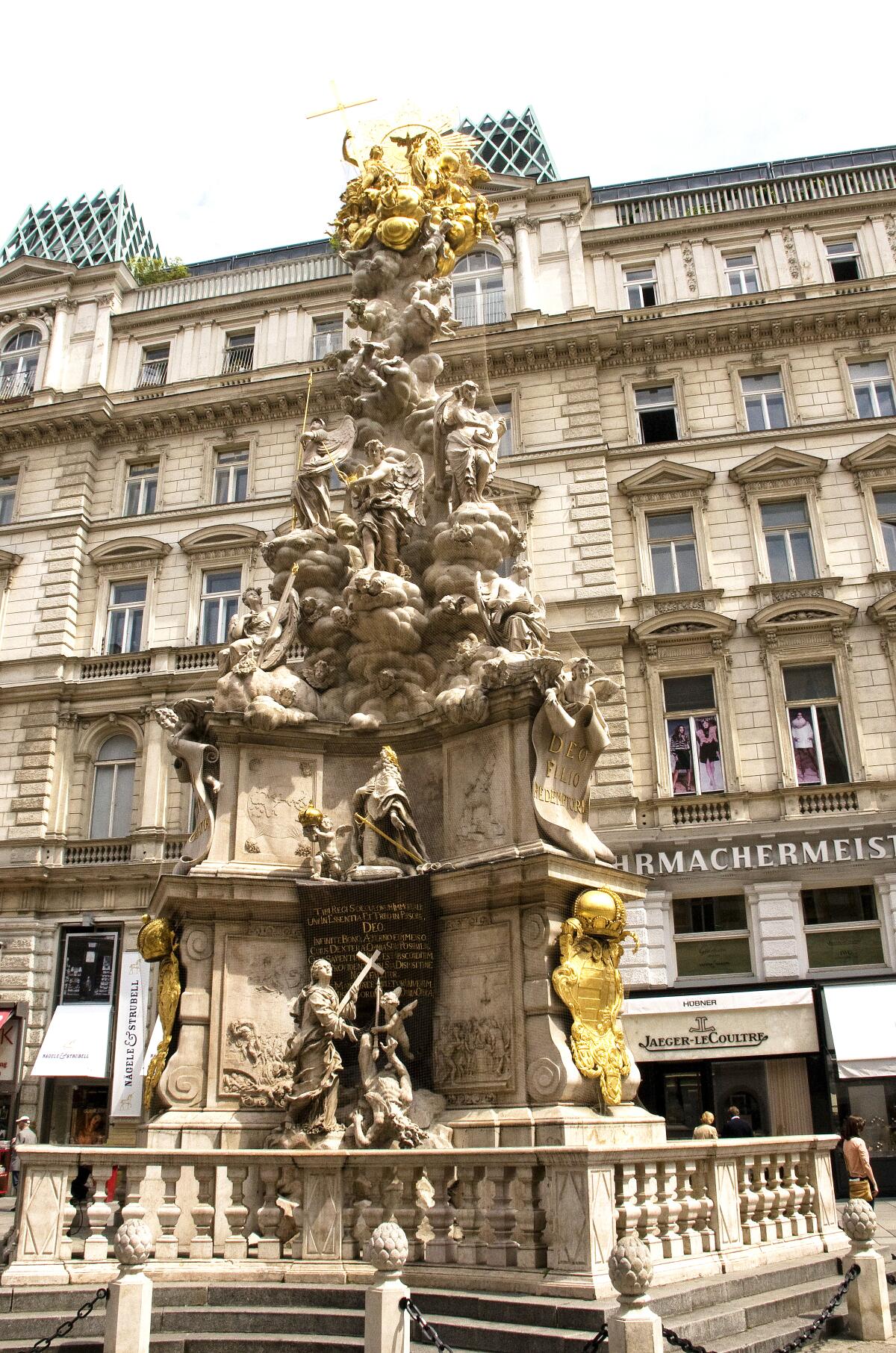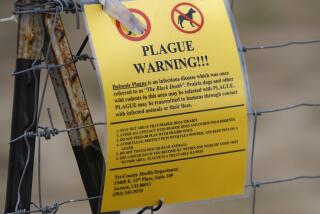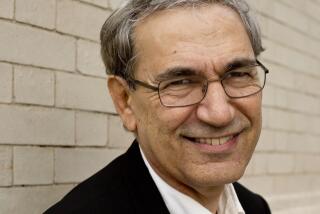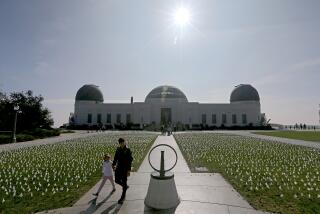Commentary: U.S. should build a memorial ‘plague column’ for COVID-19, but where? Hint: Trump

Sculptures commemorating plagues were common in Europe. Our art critic suggests America could build its own, and Trump provides inspiration for where.
Plague columns don’t exist in the United States. The nation was founded too late, after the 17th and early 18th century European heyday of memorials built to mark the end of a blistering contagion.
An epidemic’s brutal cost in human lives and its myriad disruptions of daily routine are very real. Yet the deeper motivation for creating this memorial genre of public art springs from a less quantifiable truth: The existential dread that seeps into every corner of a plague-ravaged society’s experience must be shaken off.
Catharsis is neither effortless nor automatic. Art does not heal, but it does offer solace.
Plague columns haven’t been much in fashion for nearly 300 years. But as the horrendous toll of death and suffering from today’s modern coronavirus plague continues to climb, the time may have come to consider reviving this once common genre of public art.
When the pandemic is finally behind us, where should we erect our first memorial plague column? And who should design it? I have a few ideas.
From Constantinople to London, where the scourge of bacterially produced bubonic plague had been a way of life for centuries, cities and towns got into the habit of erecting memorials in a prominent civic square after the pestilence subsided. The format for a plague column was fairly standard: a Doric or Corinthian column erected on top of a base and embellished with assorted statuary.
The column itself, subtly recalling the glorious legacy of ancient Greece and Rome, would signify society’s enduring continuity. The statues represented whatever power figures held sway when the column went up, whether religious or aristocratic. The donors of funds to build the memorial — public or private, church or state — got to pick.
The design for plague columns is generally thought to have derived from a plaza monument in front of Rome’s Church of St. Mary Major, or Santa Maria Maggiore, started in the 5th century but expanded over the years to become the city’s second biggest basilica (after the Vatican). The enormous, lavishly decorated church, built just a stone’s throw from the ancient Roman Forum, was meant to establish the city as not only the heart of the old classical world but of the new Christian world as well.
In 1614 the church made a momentous addition. An actual Corinthian column from the Forum’s ruins was hauled over and set up on a pedestal out front. Imperial Rome had a habit of putting the current emperor’s statue on top of a prominently placed column, but now Caesar was switched out in favor of the Virgin Mary.
The timing for the Marian column was ripe. The Catholic Church was mounting its art-fueled offensive to stem the rising tide of Protestantism, and the Mother of God assumed pride of place. Mary columns started turning up at every opportunity, once Europe’s Baroque era got underway.
The end of a local plague was nothing if not an opening to bring in the blessed virgin, protector of humanity. In no time, distinctions between a Mary column and a plague column blurred. The Trinity — Father, Son and Holy Spirit — became another common embellishment.
Two exceptional plague columns still stand today — one in Austria, built in the wake of the 1679 Great Vienna Plague that killed more than 75,000 people in the seat of Habsburg power; and one in the eastern Czech Republic, where a ferocious plague decimated the once-thriving university town of Olomouc between 1713 and 1715. “Over the top” hardly begins to describe their very different designs.
The Czech monument is massive. At least seven artists contributed, most notably Olomouc stonemason Václav Render and German sculptor Ondrej Zahner.

Called the Trinity Column, it took nearly 40 years to build. The base is actually a small building — a chapel — while the structure is adorned with 33 larger-than-life statues and reliefs of apostles, martyred saints and the Virgin. As a great big thank-you note for the end of a bubonic plague that had eradicated almost the entire local population, it signaled to all that the city was up and running again.
A golden trinity erupts at the top, about 100 feet up, past a golden sphere embedded in the column. The sphere is actually a cannonball, left by a Prussian bombardment in 1758. Rather than repair the damage, the savvy city instead decided to gild the cannonball — highlighting the monument’s imperviousness to attack. A statue of martyred St. Sebastian was added for good measure.
Sebastian, a Roman soldier who survived being shot with multiple arrows, was revered as a protector from plague. (In Greco-Roman myth, Apollo sometimes vanquished enemies by shooting plague-arrows from the heavens.) The Olomouc monument folds civic and cultural history into itself and is the only plague column to rank as a UNESCO World Heritage site.
Vienna’s slightly earlier plague column is even more florid. Wrapped in so many billowing clouds and encrusted statues, the usual supporting column inside has all but disappeared.
Positioned on the Graben, a medieval pedestrian street downtown, the monument provides a grand theatrical flourish. A tall, three-sided pyramid sends figures of the father, son and holy spirit aloft, as if wafted on a turbulent gust of puffy clouds and a flock of fluttering cherubs.
Like its Czech counterpart, it was realized by multiple artists. Perhaps the most notable was the young Johann Bernhard Fischer von Erlach, a designer who had worked in Bernini’s Rome studio and later became official architect of the Habsburg court.
This column took 11 years to build. In the process, its official reason for being — overcoming the 1679 plague — merged with a great military victory: halting a 1683 invasion by the Ottoman Turks. Imperial propaganda soon entered the mix.
Holy Roman Emperor Leopold I used the monument to burnish his image. He actually had fled town during the epidemic, while his part in defeating the invading Turks was eclipsed by the more robust efforts of a rival prince. So he used the flashy monument as an opportunity to embroider his role in squelching both enemies.
When the Vienna plague column was finally dedicated in 1694, it included a sculpture of Leopold humbly kneeling as a personification of faith, which practically begged for imperial dispensation. Isn’t forgiveness what was being promised to the faithful in the gilded resurrection held aloft at the top of the magnificent sculptural pyramid? Surely, the emperor deserved no less.
Painter Antoine-Jean Gros made the French general into a military hero, turning troublesome truth into feel-good fiction.
Over the next century, the decline of church authority and the rise of science markedly affected the handling, minimizing and prevention of disease outbreaks. American pestilence popped up periodically afterward, at least since the Barbary Plague was hushed up in Gilded Age San Francisco for fear of ruining the booming local produce industry, circa 1900. But along with Baroque styles, plague columns had long-since petered out as civic undertakings.
Now, however, COVID-19 has proved to be such an epic trauma, its global ramifications so profound, that maybe it’s time to initiate the first U.S. memorial plague column.
What a modern version might look like is anyone’s guess. Certainly it wouldn’t copy its European predecessors — partly because the current catastrophe is not just a local event and partly because the United States is a secular nation.
Who should design our plague column? Taking a cue from Vienna and Olomouc, I’d suggest tasking a whole group of gifted artists. Organize an open competition, select six or eight exceptionally promising designs — then set all of them aside. Have the successful artists come together to collaborate on one collective plan.
The process would perhaps be slow and cumbersome, but it would make an essential point. The U.S. pandemic represents the colossal failure of our New Gilded Age society, where the top-down, winner-take-all philosophy of the last 40 years has been complicit in shredding America’s hard-fought advances in equality and social justice. The pandemic has laid bare that tragedy in the starkest terms.
A camel is a horse designed by committee, the old joke goes, but there’s nothing wrong with camels. Indeed, right now an artful camel might be just the ticket.
Where should our plague column be erected? That one’s easy: near the corner of Fifth Avenue and 56th Street in New York, the city where the disaster has been cruelest and the death toll highest. At that notorious intersection, the potential for poetic justice is most resonant.
Trump Tower, which stands on that spot, could be seized by eminent domain. A provision in the Constitution’s Bill of Rights allows expropriation of private property for public use in order to fulfill a critical need.
Fairly compensate the residents and let the chosen artists decide: Repurpose the entire building for public benefit, or demolish it and let a new plague column rise in its place. Few things are more pressing than eradicating the social pestilence symbolized by the place.
More to Read
The biggest entertainment stories
Get our big stories about Hollywood, film, television, music, arts, culture and more right in your inbox as soon as they publish.
You may occasionally receive promotional content from the Los Angeles Times.











